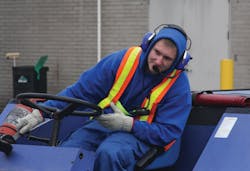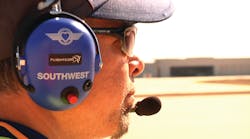We added a Product Leader category to our popular Ground Support Leaders of the Year awards for this year. At last month's Cygnus Aviation Expo, we officially recognized Flightcom Corporation, Portland, OR, for its wireless ground support communication system.
The company's headsets – both wired and wireless – are already supporting hundreds of commercial and military flight crews and ground support personnel at more than 40 U.S. airports.
Last December, however, the company won a major contract with Southwest Airlines to provide a wireless ground support system for pushbacks outside Southwest's 420 gates at 73 airports in 37 states for more than 3,400 flights a day across the United States.
How does system work? Here's a basic explanation of its four main components:
- The ComHub: Essentially, the heart of the system. The ComHub connects the pushback driver and the wing walkers to a DECT-based wireless network. During pushback, the ComHub, carried inside a bright yellow weather-resistant bag, is connected to the plane's interphone so that the driver can talk directly to the flight deck.
- The Wireless Headsets: One for the pushback driver and, typically, two for the wing walkers (although the system can work with as many as four wing walkers). The driver's headset provides a transmission range of 1,600 feet – the "footprint" of the plane – with the wing walkers; a push-to-talk button on the driver's headset allows for direct communication with the flight deck. Headsets for the wing walkers keep these important guides in continuous communication with the driver on an open mic.
- Water-Proof Charging Case: Everything fits into an unbreakable, airtight and dustproof carry case that can easily be wheeled to wherever it needs to be. A convenient, built-in battery charger provides power for all the components. The case can easily plug into a standard AC outlet and provide the headsets a full charge in two hours that's good for 24 hours of use.
There's more to the system – and more to its potential aviation uses besides pushing back planes from gates. We talked with a few Flightcom executives in sales, marketing and engineering and here's what they had to say about what makes the wireless system an award-winner.
TEAMWORK
On a loud, busy ramp with the pressure always on to make the turn, the difference between costly work injuries and hundreds of thousands of dollars in damage to aircraft is often measured in fractions of a second.
So much the better then, if the entire ground team can hear one another and let their own voices be heard to stop an accident from happening.
"Once we got on the ramp, we realized flat out that there was no good communication system for the entire ground support team," says Simon Broadley, vice president of engineering for Flightcom.
Before striking the deal with Flightcom last year, Southwest Airlines was relying on what most airlines relied on for pushbacks. The pushback driver wore the sole headset that was plugged into the aircraft. Meanwhile, the wing walkers relied on what wing walkers had relied on for the past half century – hand signals.
Hand signals, of course, only work when they can be seen. Broadley told us a story about a driver pushing back an A380. His wing walkers, however, stood in similar positions for smaller aircraft.
"The engine blocked them from the driver's view; one of the wing walkers saw trouble, but couldn't get the driver's attention with his signals," Broadley says. "Finally, the wing walker sprinted to the pushback and put the 'stop' signal right in the driver's face and averted a bad accident."
As Broadley sees it, the wing walker is crucial to a safe pushback, but literally had no voice in the matter without the wireless headsets.
"Wing walkers were living the life of silence," Broadley says. "They just were not able to have any effective communication. Now, when a wing walker sees a problem, he can say something right away."
"You put a headset on a wing walker, and he will immediately stand up straighter," says Chris Hawley, principal, C.S. Hawley & Associates, who develops marketing campaigns for Flightcom. "It's like somebody flipped a switch and the wing walkers know that they are critical members in this process."
Studies by the Flight Safety Foundation show that human factors – in other words, mistakes we can only blame ourselves for making – are the primary culprit in ramp accidents.
"The wireless system not only enables communication between the flight deck and ground crew," says Michael Walsh, director of business development for Flightcom, "it optimizes communication by controlling who can talk to whom and under what circumstances."
All ground personnel, for example, can hear the flight deck on an open mic. But to minimize confusing crosstalk, only the driver can talk directly to the flight deck with a push-to-talk feature on his headset, which also overrides the open mic.
The pilot can also be heard. "We purposefully made the pilot's voice louder than anyone else to give it the 'voice of God' aspect," Broadley says.
Overall, the system gives the pushback driver the chance to better manage his team during pushback.
"We've heard positive feedback from ground crews using the system that the stress levels really go down," Broadley adds. "It's often the case that individual members of the ground crew just focus on their own individual tasks. A driver might be so focused on that tow bar, for example, that he doesn't see the wing walker's signals. This way everyone can hear and be heard and that really helps make these individuals operate like a real team."
After the pushback, the driver removes the ComHub from the aircraft (the bag also has a long, red flag that says "REMOVE BEFORE FLIGHT") and displays it to the flight deck. However, a safety backup built into the system alerts the pilot if the bag remains on the plane.
DECT-BASED WIRELESS
One key to the Flightcom system is in the choice of technology to hear and speak without the wire. A wireless system transmits voices largely in one of two ways – either by incorporating DECT (Digitally Enhanced Cordless Telecommunications) or Bluetooth.
"The first forays with wireless systems on the ramp used Bluetooth technology," Broadley explains.
But there are several drawbacks to Bluetooth.
"Bluetooth is meant for close communications," he adds, "within 300, maybe 500 feet at most."
Bluetooth transmissions are also subject to interference from other communication devices – especially those operating on the 2.4 GHz or 5 GHz channels – and can even be blocked by physical barriers – something there's quite a lot of on the ramp.
DECT, on the other hand, can offer better coverage than Bluetooth. The range of transmission can extend to 1,600 feet. The Flightcom system also uses DECT 6.0 and is less subject to interference in the 30 MHz to 1.8 GHz channels. What's more, DECT can bounce its signal up, over and around objects to establish the best connection.
Flightcom's wireless system is also full-duplex – meaning it allows communication in both directions simultaneously. The term multiplexing is also often used to describe full-duplex communication between more than two parties. Full-duplex or multiplex capability is important for ground support communication since it lets all personnel to speak and hears other at the same time.
Half-duplex systems, on the other hand, allow communication in both direction, too – but only one direction at a time. Once one person starts transmitting, all other transmissions are blocked until the first transmission is over.
HEARING PROTECTION
While the wireless headsets can be viewed as merely a better way to communicate on the ramp, Flightcom's equipment also provides excellent hearing protection. OSHA regulations require hearing protection when the time-weighted average noise level exceeds 85 decibels.
A Noise Reduction Rating is a measurement that's also in decibels. Simply subtract the NRR from the average noise level, and users can tell how much hearing protection they'll get. Flightcom headsets are rated at 24 decibels. So, if noise levels on the ramp work out to 71 decibels, then the headsets cut that noise down to 47 decibels. By comparison, a normal conversation at three feet measures 65 decibels.
And lest we forget to emphasize this point, the Flightcom executives we interviewed reiterated that there's more than one way wireless equipment can be considered "wireless." Some wireless headsets, for example, may still require a wire to a radio or a belt pack. In addition, the transmission range for such devices aren't likely to be as robust compared to the Flightcom system.
"Wires are a real sore spot with airlines since they are always breaking," Broadley says.
Walsh says it's a question of "when not if," wired headsets will need to be repaired. He says the repair issue really gets the airline's attention when it comes to another possible ground support use for the Flightcom system – deicing.
"The typical wired headset used in deicing could be repaired eight to 12 times annually," Walsh adds. "Ninety percent of the repairs for wired headsets are for either the wires or other cables that need to be installed on the deicing equipment.
Such an after-market installation, Walsh also notes, is expensive and can be eliminated with a true wireless system.
"And anyone in the bucket loves that they aren't tethered," Walsh adds.
The setup is different for deicing operations. A vehicle-mounted base station provides communication between the driver and the deicer. But the system can also be configured to provide push-to-talk communication with ground control or other teams by way of a two-way mobile radio.
By the way, Walsh thinks that maintenance "is right behind" deicing as another use for the Flightcom system.
In this instance, the ComHub supplies hands-free communication to the maintenance crew that can be positioned inside or outside the aircraft.
"There are instances where one tech on the inside of the aircraft can be banging on the interior of the plane in order to get the attention of the guys outside," Walsh says.
Like the deicing application, however, the maintenance setup can also be configured with push-to-talk via portable radios.
Finally, the headsets are built to take ramp conditions. In fact, the company's first wireless communication system was marketed to fire fighters.
"Every customer thinks they are the most abusive to gear," Broadley says. "Fire fighters consider the headsets to be what they call 'turnout' gear – something they throw on and expect to work. But ramp workers are more abusive than fire fighters."


